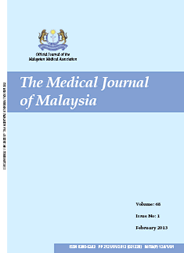MJM, Vol 70 Supplement 1 September 2015
Screening for frailty among the elderly to allow
targeted health promotion and intervention in Malaysia
*Julius Centre University Malaya, Department of Social and Preventive Medicine, Faculty of Medicine, University of Malaya, Kuala Lumpur, Malaysia, **Department of Geriatrics, Faculty of Medicine, University of Malaya, Kuala Lumpur, Malaysia, ***District Health Office Johor Bahru, Johor, Malaysia, ****Public Health Laboratory Johor Bahru, Johor, Malaysia
ABSTRACT
Introduction: By 2035, Malaysia will share the definition of an ageing nation by current demographic projections. In middle income developing countries like Malaysia, public investments are still being channelled to the Sustainable Development Goals reducing available resources for the aged. Hence, this study was to stratify the population based on their frailty status and identify the influence of cognitive status, self-rated health, frailty markers and falls on frailty to allow targeted services to be planned for them.
Methods: This is a cross-sectional study involving 789 urban community dwelling elderly in Malaysia to assess the geriatric syndrome of frailty. A multidimensional frailty assessment tool incorporating 40 items that represented assets and deficits in an elderly was used to obtain a final frailty score. Cognition was assessed using the Mini Mental State Examination (MMSE). Apart from socio-demographic profiles, history of falls and self-rated health were also determined. Grip strength and walking speed was obtained as markers of physical frailty.
Results: The response rate for the study was 75.8% from the 1040 elderly. The weighted prevalence estimate for pre-frail was 67.7 per cent and 5.7 per cent for frail elders. The remaining 26.6 per cent were considered non-frail. Ordinal regression analysis of cognitive status, self-rated health, frailty markers such as grip strength and walking speed and a history of fall showed positive associations to increasing frailty levels with only grip strength losing that association in the multivariate analysis.
Conclusion: This study highlights that cognitive status, how the elders perceive their own health and upper and lower body strength are important correlates of frailty. This multidimensional frailty screening tool is easily administered at a primary care level and allows the health practitioner to stratify their elders to the available care.
Keywords: frailty, elderly, frailty screening tool, ageing
